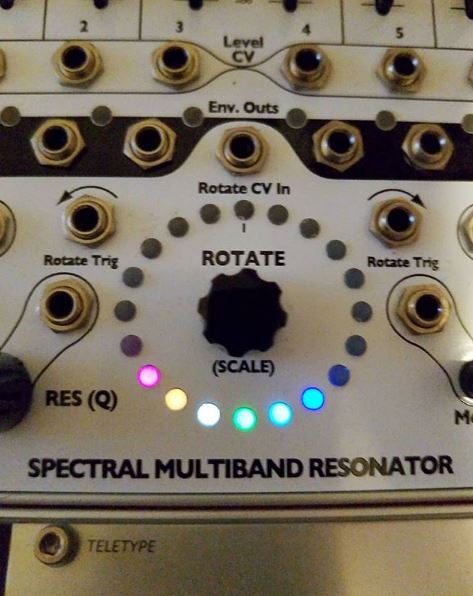
The 4ms SMR is a bank of 6 bandpass filters that can act as a graphic equalizer or as (approximate) sine wave oscillators. It has an unusual system for assigning frequencies: built-in or custom scales assigned to a ring of 20 notes, and LEDs that light up in the color of the channel assigned to that note. The channels can rotate around the ring or be spread out, can be “nudged” by external inputs or locked to a specific pitch. It’s a design that encourages unusual new composition practices, but at the same time, can complicate more traditional ones. It’s also a very pretty light show.
What I was hoping to use it for was:
- Modal synthesis, similar to Rings or Rainmaker. Fewer bands, but specific control over their frequencies and levels. In this area it’s kind of a disappointment, but it’s possible that it can still be a partner in feedback loops with other gear.
- The sort of few-oscillator additive/harmonic patch like I did a couple of times with the ER-301. This… might still be doable, but requires (A) customizing a scale to give nice harmonic multiplications, (B) multing a pitch signal into both “nudge” inputs, which might wind up requiring a buffered multiple, a utility module which I’ve dodged so far, and (C) adjusting the “nudge” input tracking so it properly tracks 1V/OCT. Which it does not, right now.
The procedure in the manual to adjust tracking didn’t work — and while the newest firmware is supposed to improve tracking, trying to upgrade to it also didn’t work. I’ve written to 4ms tech support about it.
Qu-Bit Prism is a filter, delay and bitcrusher in one smallish module. The sound of it is quite good, and the delay gets into comb filter territory (a super short delay with the right feedback configuration does phase cancellation stuff that acts as a filter instead of an echo). But the delay doesn’t react well to modulation, and a single knob controls the delay mix and feedback. You can’t have a loud single slapback, nor a pure delay without the dry signal, nor chorus or flanging, nor physical modeling uses except at a fixed pitch. (You can change the pitch but it takes a second or so to slide to the new one, so it’s not practical.)
A delay with this much limitation is mostly good as an end-of-chain effect, or possibly in feedback loops with a mixer. For end-of-chain, I might as well use a plugin. For feedback loops, I’ll have the T-Rackonizer which I expect to be way ahead of it (though minus a bitcrusher, but that’s not something I care a lot about).
Here’s my plan now:
- Judge SMR on its own merits, rather than hopes, expectations and disappointments.
- Don’t worry too much about the additive oscillator patch. If SMR can’t do it, Stages can (if a bit primitively) and it’s not a common enough thing to warrant buying gear specifically for it.
- Don’t buy anything until KnobCon.
- Don’t sell anything until KnobCon that wasn’t already on my sell list. That will give me time to settle in with this new and somewhat thorny gear, see how it all interacts and make better decisions.
- New gear arrives today. Check that out, enjoy it, see how it interacts with the other new stuff… maybe Dynamo is just what SMR needs, maybe T-Rackonizer makes the Prism moot, maybe the HD mk3 is so awesome I want to sell two other things and get a second one.
- But after KnobCon, be kind of merciless about the focus thing. Not necessarily with snap decisions, but resist feature creep.
